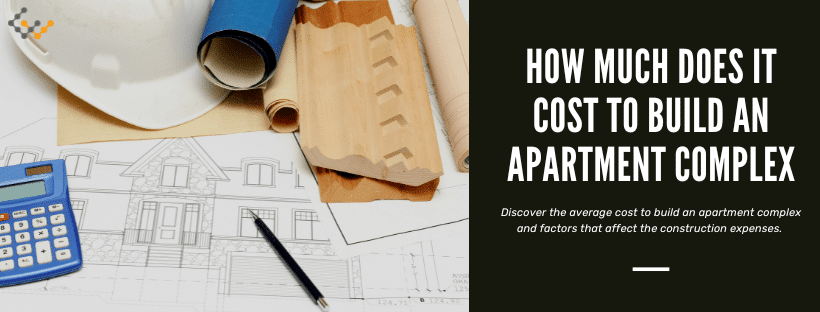How Much Does it Cost to Build an Apartment Complex

The decision to invest in real estate does not always come from purchasing pre-existing property. With a better understanding of multifamily apartment costs, some investors may hope to build from the ground up.
Stages of Apartment Complex Construction
Building an apartment complex requires numerous steps. The process typically involves three phases.
Pre-Construction
The pre-construction process is the planning and development phase. The focus here is on creating the project, finding and purchasing the property, working with the city to develop a plan, and obtaining all necessary financing to move the project forward.
The pre-construction phase typically involves the designs, permitting, drawings from architects, and the overall negotiations with contractors. Contractors typically submit bids for the project, and investors must choose the one they hope to work with moving forward.
Answer a few questions and get custom mortgage quotes. We'll match you with offers from our network of 650+ lenders.
Construction
The next phase is construction, and that is when the groundbreaking of the project begins. It includes building the foundation, walls, roof, and everything that goes along with that process. The construction phase includes the building of the structure as well as the finishing out of each of the units. It can also include any other site development needs.
Post-Construction
Post-construction does not just describe the process of completion but also the site clean-up, final updates, and final code approval. All inspections and payments should occur at this stage.
Expenses Associated with Apartment Complex Construction
The following are some examples of the costs associated with building an apartment complex.
Land and Site Development Costs
Land and site development costs are typically the initial purchase. This includes the process of finding, purchasing, and then clearing and developing the land to meet the property’s needs. This often entails not just the development of the property’s land but also working to meet city and zoning regulations.
Construction Materials
The hard costs associated with building an apartment complex include the materials themselves. This should also factor in the costs of the equipment needed to build the property, including all site work needed, utility costs, and any expenses related to the actual building process.
Labor Costs
Labor costs represent the cost of paying workers to do the actual physical process of building the property. Labor costs also involve the cost of developing the project, overseeing and managing the process, and managing the ongoing costs of the finishing process.
Professional Service Costs
In every apartment complex, there is likely to be a need for a wide range of professional services. This includes real estate agents to find and negotiate the purchase of the property, attorneys to manage the development negotiations and contracts, and title companies. There is also the need for architects and licensed plumbers, and electricians to manage the process. Inspections and building contractor oversight may also be necessary.
Financing Costs
Financing costs represent the cost of borrowing money to develop and build the property. Typically this will include interest rates along with origination fees for the loan and all associated finance charges. These funds may come from a lender, or they may be covered by the investor.
Factors That Impact the Cost of Apartment Complex Construction
To determine the multifamily apartment cost, investors must consider all of the individual factors within their region and their building processes that could impact pricing. Though a formal quote is an ideal way to learn the true costs associated with the process, some factors to keep in mind include the following.
Location
Paramount to cost is location. Some regions are far more expensive to build in than others. The cost of the land itself often contributes to as much as 20 percent of the overall cost of building. Local costs play a role in determining what this figure is.
Ultimately, costs in urban areas tend to be higher than in rural though demand may be higher in urban communities. The desirability of the city and surrounding area plays a role in location-related costs as well.
Market Demand
Market demand within any community plays a significant role in cost expectations. For example, in some communities, more affordable housing is desirable and necessary, lowering the overall cost of the build. Other communities demand a more luxurious property style, which will increase the cost to build as materials and design elements are higher.
In addition to market demand are zoning policy rules. In some areas, affordable housing requirements limit the level of luxury build possible. In many affordable housing communities, the rents may not make a project worthwhile, but government incentives – that may be available – could help to make that more of a lucrative opportunity.
Design and Amenities
Multifamily apartment costs may also range based on the design of the property, the size and scope of the project, and the amenities that extend beyond the units themselves. For some property developments, onsite amenities like fitness centers, pools, clubhouses, playgrounds, and garage or storage facilities will increase the overall costs.
Material Quality
The cost of materials has changed significantly in the last few years, thanks in part to the supply chain limitations. However, there is also a difference in the quality of the materials used. In situations where higher-quality, more sustainable, or even hard-to-find materials are necessary for the project’s features or design, the costs will rise. Inferior materials are not an option due to building code requirements.
Labor Costs
Labor costs range based on the economic conditions in any area. Labor costs are higher in some rural areas where labor forces may be limited. In areas where significant construction is occurring, competition for available labor may also influence the cost of it.
What’s the Average Cost of Building an Apartment Complex?
Numerous factors play a role in determining the overall average multifamily apartment cost. Data shows that the average cost in the United States is about $12.5 million for an apartment building with 50 units, which is a 5-story mid-rise, with the national average falling between $5.4 and $59 million. The cost per unit to build apartment complex structures can also be a bit harder to determine since factors such as size and overall expectations within any community play a role in this.
The average cost per square foot is nearly $400. Utilizing that figure, investors can determine a bit more detail based on what they specifically plan to build.
How to Manage Your Apartment Complex Construction Costs
Working with a lender and a developer can help to keep the costs of building an apartment complex under control. Good oversight from a highly specialized lender and construction company ensures the build can go well and stay within budget.
Wrapping Things Up
The cost of a multifamily apartment complex is typically much higher than what would be paid for in most other types of residential developments. With more regulatory control and oversight as well as a wide range of limitations on the process, companies may find the costs will vary significantly from one location and one project to the next.
Smaller-sized, more rurally located projects may be more affordable, but higher-quality properties in desirable communities may yield bigger rents. For most investors, finding the balance between these areas is ideal for creating a profitable and desirable place to live.

